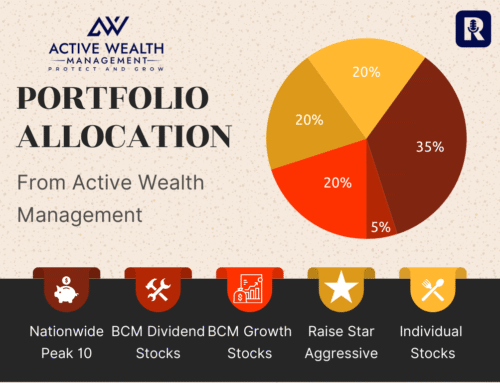A Fresh Start for Your Financial Future
Labor Day marks more than just the unofficial end of summer—it’s also the perfect time to hit reset and refocus on your financial goals. Just as families prepare kids to head back to school and businesses gear up for the fall season, this period is a powerful reminder for retirees and pre-retirees to revisit their long-term financial strategy.
Too many Americans procrastinate when it comes to retirement planning. But here’s the truth: every year you delay is a year you lose compounding power, potential market growth, and tax planning opportunities. That’s why the weeks immediately following Labor Day present the ideal moment to jump start your retirement catch-up strategy.
This article will outline actionable steps to take—starting now—that will help you:
- Boost your 401(k) savings rate to at least 15% of your paycheck.
- Optimize your workplace retirement plan by reallocating to lower-cost, lower-volatility options.
- Replace bonds with fixed indexed annuities (FIAs) to improve income security and reduce market risk.
- Begin Roth IRA conversions (strategically!) to reduce your tax burden in retirement.
- Plan your withdrawal strategy so you don’t outlive your savings.
- Assess your retirement income surplus (or gap) in light of inflation.
- Teach your children and grandchildren the basics of financial literacy.
Let’s dive in—step by step.
Step 1: Save 15% or More Into Your 401(k)
If you’ve been coasting along saving 5–8% into your 401(k), it’s time to get serious. Research consistently shows that workers need to contribute 15%–20% of their income during their working years to build a retirement nest egg that will sustain them for decades.
That may sound like a lot, but remember—you’re not on your own:
- Employer matches help. Many companies match 50%–100% of contributions up to 3–6% of salary. That’s free money, and it gets you closer to your 15% target faster.
- Catch-up contributions matter. If you’re age 50 or older, the IRS allows an additional $7,500 per year (2025 limit), on top of the $23,000 contribution maximum.
- Automatic increases work. Most plans allow you to schedule a 1% increase each year. This helps you reach the 15% threshold without feeling the pinch all at once.
Action Plan: Log into your 401(k) portal this week and adjust your contribution rate. If you’re at 8%, bump it to 10% now, and set an auto-escalation to 15% over the next 2–3 years.
Step 2: Optimize Your 401(k) Investment Options
Most workers set their 401(k) investments once when they join a company—and never revisit them. Unfortunately, this often leaves them in high-expense funds with high standard deviations (volatility), which erodes returns over time.
Here’s what to do:
- Review expense ratios. A difference of 1% in annual fees can cost you hundreds of thousands of dollars over a career. Always lean toward low-cost index funds or institutional funds when available.
- Look at standard deviation. This measures how volatile a fund’s returns are. Lower standard deviation typically means a smoother ride—crucial as you approach retirement.
- Seek professional analysis. A fiduciary advisor can analyze the menu of investment choices in your specific 401(k) plan and recommend a reallocation tailored to your goals.
Action Plan: Schedule a review of your 401(k) this month. Ask your advisor to run a side-by-side analysis of your current fund line-up against lower-expense, lower-volatility options.
Step 3: Replace Bonds With Fixed Indexed Annuities
For decades, bonds were considered the safe side of the “60/40 portfolio.” But in today’s environment—rising rates, inflationary pressure, and bond price declines—the old model doesn’t hold up.
Instead, consider reallocating a portion of your fixed-income allocation to fixed indexed annuities (FIAs).
Why FIAs Beat Bonds for Retirement Security:
- Principal Protection: Unlike bonds, which can lose value when rates rise, FIAs guarantee your principal.
- Upside Potential: Returns are linked to a market index (such as the S&P 500), offering growth potential without downside risk.
- Tax-Deferred Growth: Earnings compound tax-deferred until withdrawal.
- Lifetime Income Options: Many FIAs offer riders that guarantee income you cannot outlive.
The Longevity Advantage
Studies show that people who own annuities live longer. A landmark paper from the National Bureau of Economic Research (NBER) found that retirees who annuitize assets tend to experience reduced stress, better health outcomes, and longer lifespans compared to those who don’t【 source: NBER Working Paper No. 20998】. The psychological security of knowing you’ll never run out of money contributes to both peace of mind and physical well-being.
Action Plan: Work with your advisor to carve out 20–40% of your retirement portfolio from bonds into fixed indexed annuities.
Step 4: Begin Roth Conversions—Delete the IRS From Your Retirement
If you’re serious about reducing your lifetime tax burden, one of the most powerful strategies is gradually converting traditional IRA dollars into Roth IRA dollars.
Why Roth Conversions Work:
- Tax-Free Growth and Withdrawals: Once in a Roth, your money grows tax-free and withdrawals are not subject to federal income tax.
- No RMDs: Unlike traditional IRAs, Roths are not subject to Required Minimum Distributions.
- Tax Diversification: Balancing taxable, tax-deferred, and tax-free accounts gives you flexibility in retirement.
Smart Conversion Tactics
- Use taxable accounts to pay the taxes. If you pay conversion taxes out of IRA funds, you shrink the converted amount. Better to use dollars from a brokerage account.
- Spread conversions over several years. Large conversions can push you into higher tax brackets. Ladder your conversions to stay in lower brackets.
- Mind the 5-year rule. Each Roth conversion has a 5-year waiting period before earnings can be withdrawn tax-free.
Action Plan: Right after Labor Day, sit down with your advisor to map out a 5–10 year Roth conversion ladder.
Step 5: Assess Your Retirement Income Gap
Do you know whether you’ll have a retirement income surplus or deficit? Too many retirees assume their nest egg is “enough” without running the numbers.
Here’s how to assess:
- Add up your guaranteed income. Include Social Security, pensions, and annuity payouts.
- Compare against expenses. Don’t forget healthcare, travel, inflation, and long-term care.
- Calculate the gap. If expenses exceed guaranteed income, you’ll need portfolio withdrawals to cover the shortfall.
Inflation Warning
Inflation silently eats away at purchasing power. If you’re already running a slight deficit, inflation can turn it into a wide gap quickly.
Action Plan: Work with an advisor to create a Retirement Income Gap Analysis. This will stress-test your portfolio against inflation scenarios.
Step 6: Live Within Your Means—Before and During Retirement
Retirement success isn’t just about income streams; it’s also about spending habits. A common rule of thumb is the 4% withdrawal rate: limit withdrawals to 4% of your assets annually. This helps preserve capital across a 25–30 year retirement horizon.
But with inflation, healthcare costs, and market uncertainty, many advisors now recommend being even more conservative—between 3.5% and 4%.
Action Plan: Review your budget. Aim to cover core living expenses (housing, healthcare, food) with guaranteed income sources. Use portfolio withdrawals for discretionary spending like travel and hobbies.
Step 7: Teach Your Kids and Grandkids Financial Literacy
One of the greatest gifts you can give future generations is financial literacy. Schools rarely teach personal finance, leaving young adults unprepared for real-world money management.
Lessons to Pass Down:
- Save at least 15% of income. Just like you’re doing now with your 401(k).
- Avoid high-interest debt. Credit cards can derail financial stability.
- Invest early. Compounding works best when started young.
- Live below your means. Lifestyle creep is the enemy of long-term wealth.
Action Plan: Take time this fall to sit down with your kids and grandkids. Share your financial journey—both wins and mistakes. Encourage them to start saving and investing early.
Step 8: Catch up with your 401K or IRA
For workers age 50 and older, the IRS provides what are called catch-up contributions—an incredibly valuable way to accelerate savings as retirement draws closer. In 2025, individuals can contribute up to $23,000 per year into a 401(k), but those over 50 can add an additional $7,500, bringing the total to $30,500 annually. This extra allowance recognizes that many people may not have saved as much as they hoped earlier in life, and it provides a structured way to make up ground quickly in the final stretch before retirement.
The same opportunity exists for IRAs. While the annual contribution limit for IRAs in 2025 is $7,000, workers age 50 and older can add a $1,000 catch-up contribution, for a total of $8,000 per year. This may not seem like a huge amount on its own, but when combined with 401(k) savings and employer matches, the extra dollars can significantly boost retirement balances over a decade or more. Because IRA contributions can be either tax-deductible (Traditional IRA) or tax-free in retirement (Roth IRA), these catch-up contributions also give older workers more flexibility when structuring their future tax strategy.
The key to maximizing these catch-up provisions is intentional planning. Don’t wait until year-end to try to squeeze in the additional dollars—spread the contributions evenly across the months following Labor Day and into the next year. Pairing catch-up contributions with smart allocation choices, such as low-cost investment options in a 401(k) or a Roth conversion strategy with an IRA, ensures these extra savings work as hard as possible for you. When combined with tools like fixed indexed annuities for safer growth, these catch-up contributions become the bridge between where your savings are today and where they need to be to fund the retirement lifestyle you want.
📊 2025 Retirement Contribution Limits (with Catch-Up Provisions)
401(k), 403(b), most 457 plans, and TSP
-
Standard limit: $23,000
-
Catch-up (age 50+): +$7,500
-
Total for age 50+: $30,500
Traditional & Roth IRAs
-
Standard limit: $7,000
-
Catch-up (age 50+): +$1,000
-
Total for age 50+: $8,000
💡 Tip: Automate these contributions right after Labor Day so you stay on track without scrambling at year-end.
Why Starting After Labor Day Matters
Momentum matters. Procrastination is the enemy of retirement success. The reason I emphasize “jump starting” right after Labor Day is because the timing works:
- You still have four months left in the calendar year to maximize 401(k) contributions.
- You can execute Roth conversions before year-end to lock in tax benefits.
- You can review your 401(k) allocations before the year’s final market swings.
- You can enter 2026 with a stronger, smarter plan in motion—rather than scrambling with last-minute adjustments.
This fall, don’t just return from vacation and dive back into routine. Take this moment as a turning point.
Bringing It All Together
Let’s summarize the key moves to make this September:
- Increase 401(k) contributions to at least 15% of pay.
- Reallocate within your 401(k) to lower-cost, lower-volatility funds.
- Replace bonds with fixed indexed annuities for growth and guaranteed income.
- Start a Roth conversion ladder—using taxable account dollars to pay taxes.
- Run a Retirement Income Gap Analysis to determine surplus or deficit.
- Stick to a 4% withdrawal strategy to preserve assets.
- Teach kids and grandkids the basics of saving, investing, and financial literacy.
- Get started with your 401K or IRA Catch-up deposit
Each of these steps compounds over time. Taken together, they can dramatically improve your odds of retiring not just comfortably—but confidently.
Ford Stokes Bio
Ford Stokes, RSSA®, MBA, is the founder of Active Wealth Management and host of the popular Retirement Results Radio Show, the most listened-to retirement show on Atlanta’s AM 920 The Answer. He is also the author of the newly released book, The Smart Retirement Plan.
As a fiduciary financial advisor and a Registered Social Security Analyst (RSSA®), Ford specializes in helping retirees and pre-retirees protect and grow their wealth, maximize Social Security benefits, and create personalized retirement income strategies.
With over two decades of financial services experience, Ford is passionate about educating Americans on how to avoid unnecessary fees, reduce taxes, and build retirement plans that last.
Let’s Get Started!
If you’re ready to jump start your retirement catch-up plan this fall, don’t wait.
As a thank-you for taking charge of your financial future, I’m offering a FREE copy of my newest book, The Smart Retirement Plan. This book will walk you through step-by-step strategies for maximizing income, minimizing taxes, and building the retirement you deserve.
👉 Call 1-888-814-0304 today or visit RetirementResults.com/PLAN to request your free copy.
Your future self will thank you.






